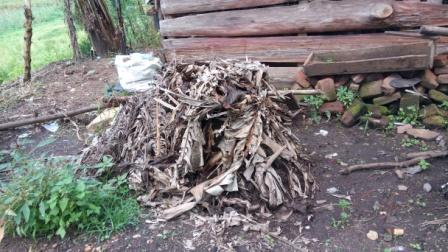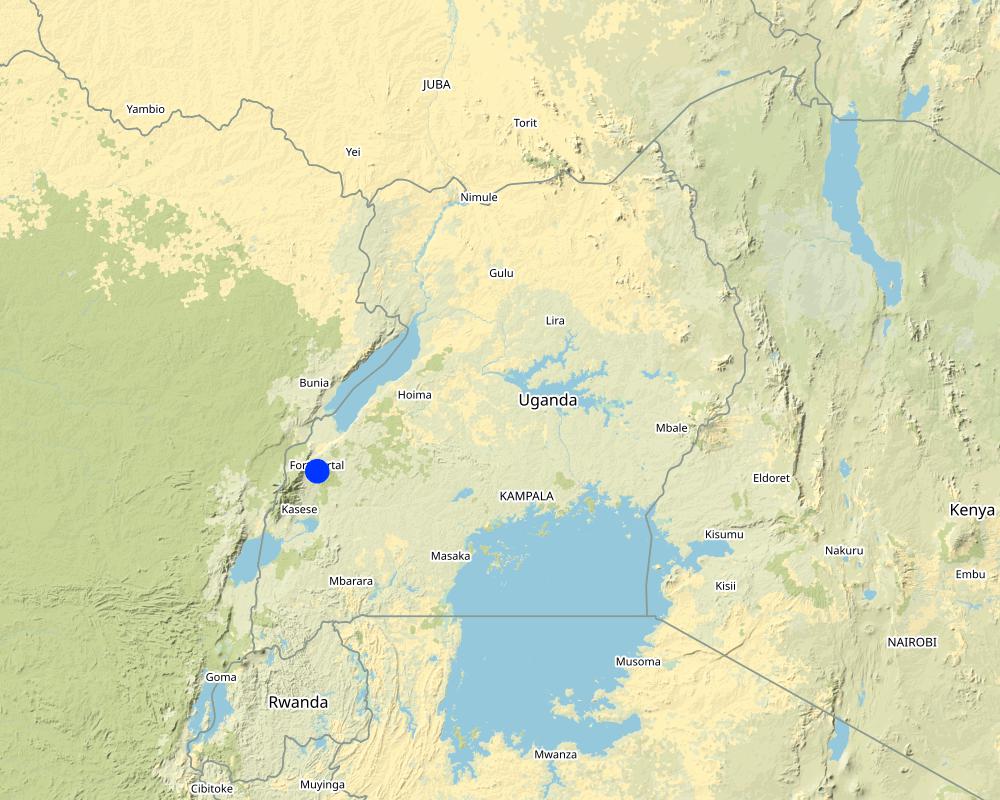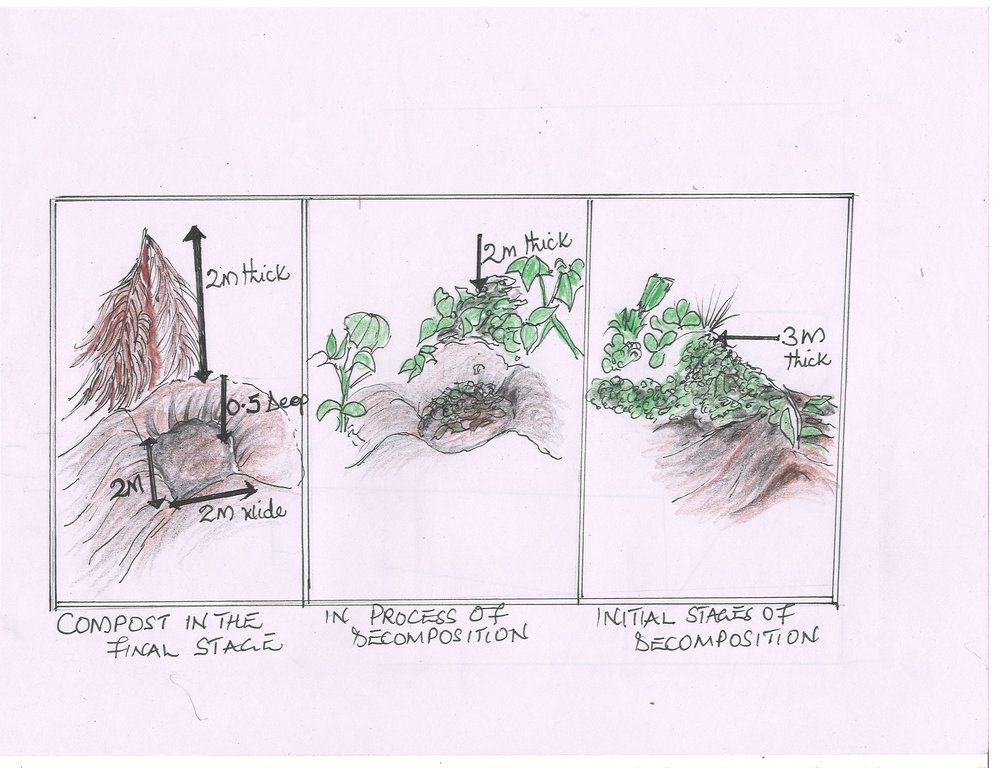Compost Production Pits for Crop Production [Uganda] [乌干达]
- 创建:
- 更新:
- 编制者: Sarah Babirye
- 编辑者: Kamugisha Rick Nelson
- 审查者: Nicole Harari, Udo Höggel, Donia Mühlematter
Olwezo lwakasasilo
technologies_3303 - 乌干达
查看章节
全部展开 全部收起1. 一般信息
1.2 参与该技术评估和文件编制的资源人员和机构的联系方式
关键资源人
土地使用者:
Baguma Innocent
0706385387
None
乌干达
有助于对技术进行记录/评估的项目名称(如相关)
Scaling-up SLM practices by smallholder farmers (IFAD)有助于对技术进行记录/评估的机构名称(如相关)
National Agricultural Research Organisation (NARO) - 乌干达1.3 关于使用通过WOCAT记录的数据的条件
(现场)数据是什么时候汇编的?:
17/10/2017
编制者和关键资源人员接受有关使用通过WOCAT记录数据的条件。:
是
1.4 所述技术的可持续性声明
这里所描述的技术在土地退化方面是否存在问题,导致无法被认为是一种可持续的土地管理技术?:
否
注释:
It is a good sustainable land management technology that enables farmers locally to make cheap organic manure to increase food production while improving the degraded areas.
2. SLM技术的说明
2.1 技术简介
技术定义:
Compost manure production is a sustainable land management practice promoted by small scale farmers by using banana, cassava, sweet potato peelings, jack fruit residues and food left overs. The aim is to improve soil fertility, increase agricultural production and household income. The technology makes nutrients more readily available to plants in a short period of time through composting. During composting, raw organic matter is transformed into stable humus which is absorbed by plants thus enabling increased production.
2.2 技术的详细说明
说明:
Compost manure application is an integrated pest, disease and soil fertility management technology that cheaply avails organic matter to increase crop/land productivity among local farmers. Farmers use locally available inputs like weeds, kitchen refuse, crop residues (maize, sorghum, millet, wheat among others) at less or no cost. These nutrients are thus made available to plants through transforming raw organic matter into stable humus, which is readily absorbed by plants. This increases agricultural and vegetable production. However, the nitrogen content in the compost can be further increased if waste plant materials such as Lantana Camara, Sesbania are integrated. Procedures to make compost manure include the following steps:
• Digging pits of about 2m length, 2 m width and 0.75 m depth.
• Placing the assorted organic materials in pit no. 1 and covering it with soil in a dome shape to prevent water from seeping into the decomposing materials. Residues so assembled should be in their raw form collected from either the kitchen, weeds from gardens, peelings and crop residues like maize and sugarcane husks. As a rule of thumb, the compost pile should be build by beginning with a bottom layer of bigger sized materials, such as maize stovers, of about 15cm height. This should also include a layer of dry vegetation, hedge or grass cuttings to about 15cm height. Sprinkling top soil and adding water by using a watering can will to moisten the whole layer. In this pit, the degradation process will take a period of 1-2 months.
• In the third month, the materials are then transferred to pit no. 2, arranged and compressed in layers and covered with soil in a dome shaped manner.
• After another spell of 4-5 months, these decomposed materials are then transferred to pit no. 3. This comprises of decomposed matter ready for use. In this last pit, manure in the final stage is always cold, dark and most importantly, less bulky. It produces a pleasant smell when spread.
In case of a banana plantation, ready compost is applied around the banana hills or in trenches between 4 banana plants. Soils with compost cannot easily be washed away by water or blown by wind as the soil particles are held tightly together with the sticky substance secreted in the process of decomposition. This glue-like structure also helps to hold moisture in the soil hence improving the structure.
The farmer selects a suitable and convenient place for the compost pit system preferably near the garden and home stead where he digs three pits. The cost of digging a compost pit depends on where the pits are to be located. If the place is easy to dig, each pit costs about UGX 5,000/=. Other costs include, hiring a spade at UGX 1,000/=, a hoe at UGX 1,000/=, a pan at UGX 1,000/= and a watering can at UGX 1,000/=, all summing up to UGX 9000/= for the whole activity. The technology improves production in both annual and perennial plants such as fodder grasses and crops through restoring degraded soils by improving soil structure, soil moisture and micro organism content. As the technology provides nutrients to plants it also reduces environmental pollution associated with inorganic fertilizer use. Nutrients are released gradually, enabling the following year’s crops to benefit as well. Weeding is done easily in areas applied with compost manure as the soil has a soft texture. Through this technology, home hygiene is improved by utilising wastes. Plant diseases and pests like banana weevils are suppressed.
However, making compost manure is challenging. It requires a lot of commitment and serious efforts to collect the kitchen and garden residues all the time. Digging a pit is quite laborious and farmers with little land find it hard to reserve land for compost pits.
This technology is an agronomic measure that helps in waste management through recycling, re-use or reduction of wastes, thereby improving sustainable land management. Maintenance is always by ensuring that compost pits are not under permanent shade and properly covered. Pits should be emptied after the process is done in preparation for the next cycle.
2.3 技术照片
2.4 技术视频
日期:
17/10/2017
位置:
FORTPORTAL, KABAROLE DIST
摄影师的名字:
Aine Amon
2.5 已应用该技术的、本评估所涵盖的国家/地区/地点
国家:
乌干达
区域/州/省:
KABAROLE
有关地点的进一步说明:
FORTPORTAL MUNICIPALITY
注释:
Coordinate points where the technology was captured were E 03017319 (Longitude) and Latitude N 004014.4
Map
×2.6 实施日期
如果不知道确切的年份,请说明大概的日期:
- 不到10年前(最近)
2.7 技术介绍
详细说明该技术是如何引入的:
- 在实验/研究期间
3. SLM技术的分类
3.1 该技术的主要目的
- 改良生产
- 减少、预防、恢复土地退化
3.2 应用该技术的当前土地利用类型

农田
- 一年一作
- 多年一作(非木材)
主要农作物(经济作物及粮食作物):
Bananas, vegetables (cabbage, amarathus among others)
如果由于技术的实施而导致土地用途发生变化,则在技术实施前说明土地利的用途。:
Land use has not changed due to the technology applied.
3.3 有关土地利用的更多信息
该技术所应用土地的供水:
- 雨养
每年的生长季节数:
- 2
3.4 该技术所属的SLM组
- 土壤肥力综合管理
- 家庭花园
3.5 技术传播
具体说明该技术的分布:
- 适用于特定场所/集中在较小区域
注释:
In case of banana plantation, the compost is applied around banana heaps and in trenches between 4 banana heap.
3.6 包含该技术的可持续土地管理措施

农艺措施
- A2:有机质/土壤肥力

结构措施
- S4:平沟、坑

管理措施
- M6:废物管理(回收、再利用或减少)
3.7 该技术强调的主要土地退化类型

土壤水蚀

化学性土壤退化
- Cn:肥力下降和有机质含量下降(非侵蚀所致)

生物性退化
- Bc:植被覆盖的减少
- Bq:数量/生物量减少
- Bl:土壤寿命损失
3.8 防止、减少或恢复土地退化
具体数量名该技术与土地退化有关的目标:
- 减少土地退化
- 修复/恢复严重退化的土地
注释:
Compost manure application reduces /restores degraded soils. This is throug improving soil structure, soil moisture and micro organism content.
4. 技术规范、实施活动、投入和成本
4.1 该技术的技术图纸
4.2 技术规范/技术图纸说明
The dimensions for the compost pits are:
Width 2 m
Length 2 m
Depth 0.5 m
Slope: Gentle slope
4.3 有关投入和成本计算的一般信息
具体说明成本和投入是如何计算的:
- 每个技术单元
其它/国家货币(具体说明):
UGX
注明美元与当地货币的汇率(如相关):1美元=:
3224.0
注明雇用劳工的每日平均工资成本:
1 Pit costs 2500/= (i.e Labour to construct a pit where the residues are deposited).
4.4 技术建立活动
| 活动 | 措施类型 | 时间 | |
|---|---|---|---|
| 1. | Select a suitable place near the garden and near the home stead | 其它措施 | Once |
| 2. | Site should not be under permanent shade | 其它措施 | Once |
| 3. | Put top soil in between different layers to quicken decomposition | 结构性的 | once |
| 4. | After filling with materials,cover with soil and make it dome shaped | 结构性的 | Once |
| 5. | leave it to settle for 4-5 months when it is fully decomposed | 其它措施 | Once |
4.5 技术建立所需要的费用和投入
| 对投入进行具体说明 | 单位 | 数量 | 单位成本 | 每项投入的总成本 | 土地使用者承担的成本% | |
|---|---|---|---|---|---|---|
| 劳动力 | Digging 3 Pits | man pit | 3.0 | 2500.0 | 7500.0 | 100.0 |
| 设备 | Hiring a hoe | pic | 1.0 | 1000.0 | 1000.0 | 100.0 |
| 设备 | Hiring a spade | pic | 1.0 | 1000.0 | 1000.0 | 100.0 |
| 设备 | Hiring a watering can | pic | 1.0 | 1000.0 | 1000.0 | 100.0 |
| 设备 | Hiring a pan | pic | 1.0 | 1000.0 | 1000.0 | 100.0 |
| 技术建立所需总成本 | 11500.0 | |||||
如果土地使用者负担的费用少于100%,请注明由谁负担其余费用:
All costs are covered by the land user (100%)
注释:
The technology is cost efficient to low income farmers.
4.6 维护/经常性活动
| 活动 | 措施类型 | 时间/频率 | |
|---|---|---|---|
| 1. | By covering the manure under decomposition | 管理 | Every 5 months |
| 2. | By empying the pits when manure is ready | 管理 | Every 5 months |
注释:
The technology has few activities on the maintenance side.
4.7 维护/经常性活动所需要的费用和投入(每年)
| 对投入进行具体说明 | 单位 | 数量 | 单位成本 | 每项投入的总成本 | 土地使用者承担的成本% | |
|---|---|---|---|---|---|---|
| 劳动力 | Emptying pits | 1.0 | 2500.0 | 2500.0 | 100.0 | |
| 设备 | Hiring a hoe | pic | 1.0 | 1000.0 | 1000.0 | 100.0 |
| 设备 | Hiring a spade | pic | 1.0 | 1000.0 | 1000.0 | 100.0 |
| 设备 | Hiring a pan | pic | 1.0 | 1000.0 | 1000.0 | 100.0 |
| 技术维护所需总成本 | 5500.0 | |||||
4.8 影响成本的最重要因素
描述影响成本的最决定性因素:
Labour. Despite the fact that the technology is highly cost effective, most farmers lack money to hire people to dig pits for them and buy the few necessary inputs like spade, hoes for the activity to take place.
5. 自然和人文环境
5.1 气候
年降雨量
- < 250毫米
- 251-500毫米
- 501-750毫米
- 751-1,000毫米
- 1,001-1,500毫米
- 1,501-2,000毫米
- 2,001-3,000毫米
- 3,001-4,000毫米
- > 4,000毫米
农业气候带
- 潮湿的
5.2 地形
平均坡度:
- 水平(0-2%)
- 缓降(3-5%)
- 平缓(6-10%)
- 滚坡(11-15%)
- 崎岖(16-30%)
- 陡峭(31-60%)
- 非常陡峭(>60%)
地形:
- 高原/平原
- 山脊
- 山坡
- 山地斜坡
- 麓坡
- 谷底
垂直分布带:
- 0-100 m a.s.l.
- 101-500 m a.s.l.
- 501-1,000 m a.s.l.
- 1,001-1,500 m a.s.l.
- 1,501-2,000 m a.s.l.
- 2,001-2,500 m a.s.l.
- 2,501-3,000 m a.s.l.
- 3,001-4,000 m a.s.l.
- > 4,000 m a.s.l.
说明该技术是否专门应用于:
- 不相关
5.3 土壤
平均土层深度:
- 非常浅(0-20厘米)
- 浅(21-50厘米)
- 中等深度(51-80厘米)
- 深(81-120厘米)
- 非常深(> 120厘米)
土壤质地(表土):
- 中粒(壤土、粉土)
土壤质地(地表以下> 20厘米):
- 中粒(壤土、粉土)
表土有机质:
- 中(1-3%)
5.4 水资源可用性和质量
地下水位表:
5-50米
地表水的可用性:
中等
水质(未处理):
仅供农业使用(灌溉)
水的盐度有问题吗?:
否
该区域正在发生洪水吗?:
否
5.5 生物多样性
物种多样性:
- 中等
栖息地多样性:
- 中等
5.6 应用该技术的土地使用者的特征
定栖或游牧:
- 定栖的
生产系统的市场定位:
- 生计(自给)
非农收入:
- > 收入的50%
相对财富水平:
- 平均水平
个人或集体:
- 个人/家庭
机械化水平:
- 手工作业
性别:
- 女人
土地使用者的年龄:
- 中年人
5.7 应用该技术的土地使用者拥有或租用的平均土地面积
- < 0.5 公顷
- 0.5-1 公顷
- 1-2 公顷
- 2-5公顷
- 5-15公顷
- 15-50公顷
- 50-100公顷
- 100-500公顷
- 500-1,000公顷
- 1,000-10,000公顷
- > 10,000公顷
这被认为是小规模、中规模还是大规模的(参照当地实际情况)?:
- 小规模的
5.8 土地所有权、土地使用权和水使用权
土地所有权:
- 个人,未命名
土地使用权:
- 个人
用水权:
- 社区(有组织)
5.9 进入服务和基础设施的通道
健康:
- 贫瘠
- 适度的
- 好
教育:
- 贫瘠
- 适度的
- 好
技术援助:
- 贫瘠
- 适度的
- 好
就业(例如非农):
- 贫瘠
- 适度的
- 好
市场:
- 贫瘠
- 适度的
- 好
能源:
- 贫瘠
- 适度的
- 好
道路和交通:
- 贫瘠
- 适度的
- 好
饮用水和卫生设施:
- 贫瘠
- 适度的
- 好
金融服务:
- 贫瘠
- 适度的
- 好
6. 影响和结论性说明
6.1 该技术的现场影响
社会经济效应
生产
作物生产
SLM之前的数量:
8Kg of bananas in 1 acre
SLM之后的数量:
25kg of banana in 1 acre
作物质量
饲料生产
饲料质量
收入和成本
农业收入
注释/具体说明:
Farmers are able with the use of this technology to harvest high yields for both home consumption and commercial purposes.
社会文化影响
食品安全/自给自足
生态影响
土壤
土壤水分
注释/具体说明:
Moisture increases to 75%
土壤流失
注释/具体说明:
Soils with composts cannot easily be blown by water and wind as the soil particles are held tightly together with the sticky substance secreted in the process. This glue-like structure also helps to hold moisture in the soil hence improving the soil texture and structure and therefore wind and rains cannot blow away the soils.
养分循环/补给
注释/具体说明:
Nutrients can be recycled in the soil over and over again in the process of applying this manure to the soil.
土壤有机物/地下C
注释/具体说明:
Breaking down of matter like weeds, shrubs, kitchen residues (banana, cassava, sweet potato peelings) into humus by the micro-organisms improve on the soil organic matter.
生物多样性:植被、动物
植被覆盖
注释/具体说明:
High fertility levels of the soils from theses decomposed composts increase the vegetation cover as a result of humus generated.
动物多样性
注释/具体说明:
The quantity of annelids like earth worms increased. This is because they feed on both live and dead organic matter. Earthworms help in the breaking down of organic matter into humus and improve on soil aeration.
害虫/疾病控制
注释/具体说明:
Besides enriching the soil with fertility, the compost manure has the ability to suppress diseases and pests in the garden like the banana weevil.
6.2 该技术的场外影响已经显现
有关影响评估的意见:
The technology has no off site impacts.
6.4 成本效益分析
技术收益与技术建立成本相比如何(从土地使用者的角度看)?
短期回报:
非常积极
长期回报:
非常积极
技术收益与技术维护成本/经常性成本相比如何(从土地使用者的角度看)?
短期回报:
非常积极
长期回报:
非常积极
6.5 技术采用
- 1-10%
在所有采用这项技术的人当中,有多少人是自发地采用该技术,即未获得任何物质奖励/付款?:
- 90-100%
6.6 适应
最近是否对该技术进行了修改以适应不断变化的条件?:
否
6.7 该技术的优点/长处/机会
| 土地使用者眼中的长处/优势/机会 |
|---|
|
Manure made on farm is cheaper than when it is brought from off farm. Organic manure improves on soil structure. |
|
Manure is readily available. Increases water holding capacity. |
| The technology improves on home hygiene. |
| 编制者或其他关键资源人员认为的长处/优势/机会 |
|---|
| It is a very cheap technology that avails manure to farmers using locally available materials. |
| Poor farmers who cannot afford buying in organic fertilizers can improve on their yields using this technology. |
6.8 技术的弱点/缺点/风险及其克服方法
| 土地使用者认为的弱点/缺点/风险 | 如何克服它们? |
|---|---|
| The technology requires a garden that is so close to the homestead since the materials are bulky to carry. | Make pits closer to the home. |
| Need to control the rainfall run off from the decomposing area. | Advisable to construct pits under shades. |
| Microbes required to release nutrients require moisture so seasonal variations may affect the system. | Farmers should always utilize the seasons' conditions to enable best microbial action. |
| 编制者或其他关键资源人员认为的弱点/缺点/风险 | 如何克服它们? |
|---|---|
| Few farmers have adopted the technology since it demands commitment. | Sensitization to farmers on the importance of organic manure. |
| There is always a bad smell before the materials are covered up hence may result to conflicts from neighbours. | Collecting the wastes faster and cover them immediately. |
7. 参考和链接
7.1 信息的方法/来源
- 实地考察、实地调查
1
- 与土地使用者的访谈
1
- 与SLM专业人员/专家的访谈
1
7.2 参考可用出版物
标题、作者、年份、ISBN:
The Effects Of Various Organic Fertilizers On Growth Biology Essay,PASCHALIS BARLAS,2013
可以从哪里获得?成本如何?
https://www.uniassignment.com/essay-samples/biology/the-effects-of-various-organic-fertilizers-on-growth-biology-essay.php
7.3 链接到网络上可用的相关信息
标题/说明:
Climate change mitigation potential of agricultural practices supported by IFAD investments by Mery Richards,Aslihan Arslan,Romina Cavatassi Todd Rosenstock
URL:
https://www.academia.edu/38512422/IFAD_RESEARCH_SERIES_35_-_Climate_change_mitigation_potential_of_agricultural_practices_supported_by_IFAD_investments_An_ex_ante_analysis
链接和模块
全部展开 全部收起链接
无链接
模块
无模块






